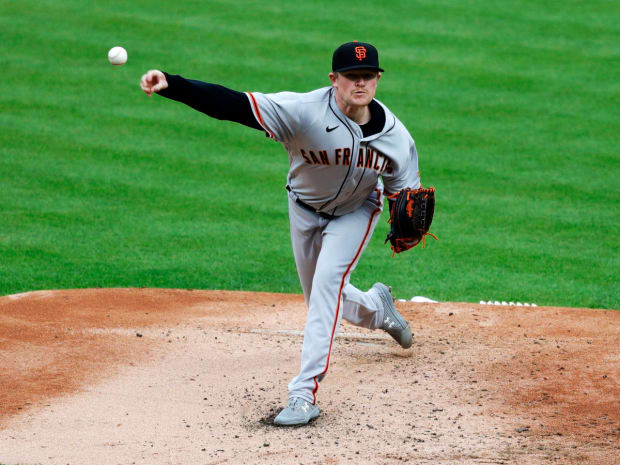High above Philadelphia, Logan Webb wondered if he had ever felt so low.
Everything had been going so well: He had grown up 100 miles northeast of Oracle Park, then been drafted by the Giants in the fourth round. His journey through the minor leagues had been mostly smooth. He had given up one run in 17 spring training innings and made the team out of camp. But three weeks into 2021, his first big league season, he could not seem to do anything right. He had been demoted to the bullpen before an injury forced San Francisco to start him again.
He trudged along the hallway of the Four Seasons and took a seat in rotationmate Kevin Gausman’s room, thinking about the clobbering he had just sustained at the hands of the Phillies: four runs in four innings to hike his ERA to 5.87.
“I don’t know if I’m good enough to pitch here,” Webb said.
Now, nearly a year later, he smiles at the memory. “He kind of looked at me like I’d said something about his mom,” Webb says. “He was mad at me. He pretty much told me to pull my head out of my ass.”
Everyone goes through this, Gausman told him. Not everyone has three plus pitches. Get out of your own way and trust your stuff. You’re a big leaguer; start acting like it.

D. Ross Cameron/USA TODAY Sports
The moment was a “turning point,” Webb says. He had a 2.71 ERA the rest of the regular season. He went 14 straight starts without allowing more than two runs, the longest single-season streak in San Francisco history. He gave up one run in 14 ⅔ innings in the postseason. He was the only pitcher in the playoffs to last seven frames more than once. On Friday, 11 ½ months after his low point, Webb, 25, will start Opening Day for the Giants.
“He realized, I'm way too good to be doing this bad,” says Gausman, who now pitches for the Blue Jays. “You know, I'm sick of being mediocre.” Gausman adds, “All of us knew it was there. We were just kind of waiting.”
Webb had to figure out who he was as a pitcher. He had to believe in that person. And he had to stop feeling sorry for himself.
Webb did not always understand how his effect affected his teammates. If he made the right pitch but saw the ball dribble past an infielder for a weak single, he might become so frustrated that he would lose control of the rest of the inning. “A dinker hit, there’s not much you can do about it,” Gausman says. “The only way you can react is positively, and I think those guys behind you see that. If you’re a guy who’s out there pouting, things aren’t gonna go your way.”
The key, says pitching coach Andrew Bailey, is “understanding that the last pitch doesn’t dictate the next pitch.”
Webb’s next start after the Philadelphia debacle came at home against the Marlins amid a downpour. The grounds crew was active all game, trying to keep the field playable. The Giants had a short bullpen and would have to lean on their starter. If Webb struggled, he would have many places to lay blame.
But he didn’t. He fell behind the first five Miami hitters but battled through seven scoreless innings. Manager Gabe Kapler was measured afterward, calling the performance “the floor” for Webb. “I feel so strongly about how good he’ll be if there’s no waste pitches and he’s in attack mode the entire game,” he told reporters. But privately, the team was thrilled. “That was the first time the excuses didn’t rise to the top,” says Bailey. “It was a really proud moment for me and Kap and [assistant pitching coach] J.P. Martinez.”
A month later, he had dragged his ERA down to 4.74 when his right shoulder began to bother him. He took the mound in Cincinnati anyway, telling himself to throw strikes and try to give the team a few good innings before he had to come out. He ended up scattering six hits and a walk over six scoreless frames.
“It kind of clicked,” he says. “I was like, Why don’t I just do that every single time?”

David Kohl/USA TODAY Sports
He can laugh about it now. His coaches and teammates had been telling him to throw strikes for as long as he could remember. He had done so in spring training because he had never thought he had a shot to make the team, so he just tried to get his work in. But then he did make the team, and suddenly the ballparks were big and the games were on TV. “That got to me,” he says. Webb was always “trying to make the perfect pitch” on the corner and missing outside the zone, Kapler says, rather than trusting that his stuff was good enough to whiff hitters over the plate.
Throw strikes? Great idea! Why didn’t somebody mention that earlier? But it never seemed that easy.
“We're not trying to throw balls,” Webb says. “[In 2020 and ’21], I would get DMs and stuff saying, ‘Hey, why can’t you throw a strike?’ I’m like, ‘I’m not trying to not throw strikes!’ Like, these guys are really, really good at hitting the baseball. When I get to a certain spot, I don't want to throw a pitch right down the middle ’cause it’ll be a home run.”
But now he realized that it also might not be. And as a ground ball pitcher, he actually wanted to induce contact.
“I learned, too, that the way I throw, if I give up a hit or a walk or something, you're one pitch away from two outs,” he says. “I’ve always done that, but I don’t know why—I kind of forgot I could do that.”
In April, he threw 43% of his offerings in the zone. Against the Reds, that figure was 48%. By September, it was 52%.
Before he could trust his stuff, Webb had to have stuff to trust. For most of his life, he threw over the top, using his natural talent more than the optimal motion. Heading into the 2019 season, the coaching staff taught him how to use his lower half to create torque. Heading into the ’20 season, he focused on generating more spin. Then right after Christmas, he got a call from Brian Bannister, the Giants’ newly hired director of pitching.
“After two months of me trying to [increase spin rate], he calls me and he goes, ‘No, we’re not doing that. You're gonna throw like Chris Sale,’” Webb says. “And I'm like, ‘Chris Sale? He’s, like, sidearm!’”
Bannister dropped Webb’s arm slot and all but took away his four-seamer. When COVID suspended the 2020 season, he spent those two months refining his motion. The result is a pitcher straight out of 2011—pounding the bottom of the zone with two-seamers and sliders. In an era when his peers chase velocity and spin rate, he rarely hits 95 mph, and he ranks in the fourth percentile in spin.

Benny Sieu/USA TODAY Sports
“I think what he's understood is the way his anatomy moves, and the way that he moves naturally is different, and he’s able to create different shapes from a different arm angle,” says Bailey. “And instead of trying to be like the rest, he’s embraced himself as kind of the outlier, and outliers do really well in this sport.” (When it is pointed out to him that the Giants seem to have collected quite a few pitchers with similar characteristics—Alex Wood and Alex Cobb also specialize in sinkers and sliders—Bailey’s mouth says, “I think we value certain things.” His eyes say, “And I’m not going to tell you why.”)
The pitching coaches also reminded Webb that the Giants employ an excellent defensive infield: Brandon Belt at first base, Tommy La Stella at second, Brandon Crawford at shortstop and Evan Longoria at third. “Let those guys do the work,” Webb says. He decided he no longer cared about strikeouts; he wanted to escape innings in 10 pitches or fewer. That meant inducing weak contact. He recorded 44 outs in the National League Division Series; 12 of them came on grounders to himself or the first baseman.
“Waste pitches,” Webb says. “Kap says that so many times. Staying away from those waste pitches and learning—like, it’s cool to watch the best pitchers in baseball. All their strikeouts are in the zone. They don’t need guys to chase. And I think I learned that I could also do that.”
He admits he still sometimes lusts after the fire graphics that people paint on gifs of 100-mph four-seamers. But he understands that’s not who he is.
“I’ll get it up there sometimes,” he says, smiling. “I get a [95] or a 6 sometimes. I think I hit a 7 once last year.” (If he did, it did not come in a game.) Then he tells a story, about the first bullpen he threw as he ramped up before spring training began: “I wasn't even trying and I was at 92, 94,” he says. “And [everyone else at the gym is] like, ‘Dude, you're gonna throw 100 this year!’ I'm like, ‘I don’t even want to throw 100 now.”
Webb still falls into his old habits sometimes. During a September game against the Padres, he did not like the feeling of the rosin bag. He gave up four runs in the fourth inning before someone switched the bag out.
“It got the best of him,” says Bailey. “That was the Webby we saw in 2019 and ’20, where one little thing can derail an outing. You also have to go through those experiences to get to the point where he was last season. From my perspective, he just didn't have the development time in the minor leagues to fully get there. He's got great stuff. It’s like the curriculum of a career: It's like he was trying to pitch in the big leagues at, like, a third grade level, right? You have to be in high school. There's a timeframe for everything.”
With Bailey’s help, Webb has developed a strategy for coping with small frustrations: He focuses on what his body is doing to give his mind time to calm down. He keeps a list of physical cues on his phone and runs through them between pitches: hip hinge. Chest to glove. Heel connection.
By the time he has finished that sequence, he is ready to move on. The last pitch does not dictate the next pitch. Logan Webb does.







